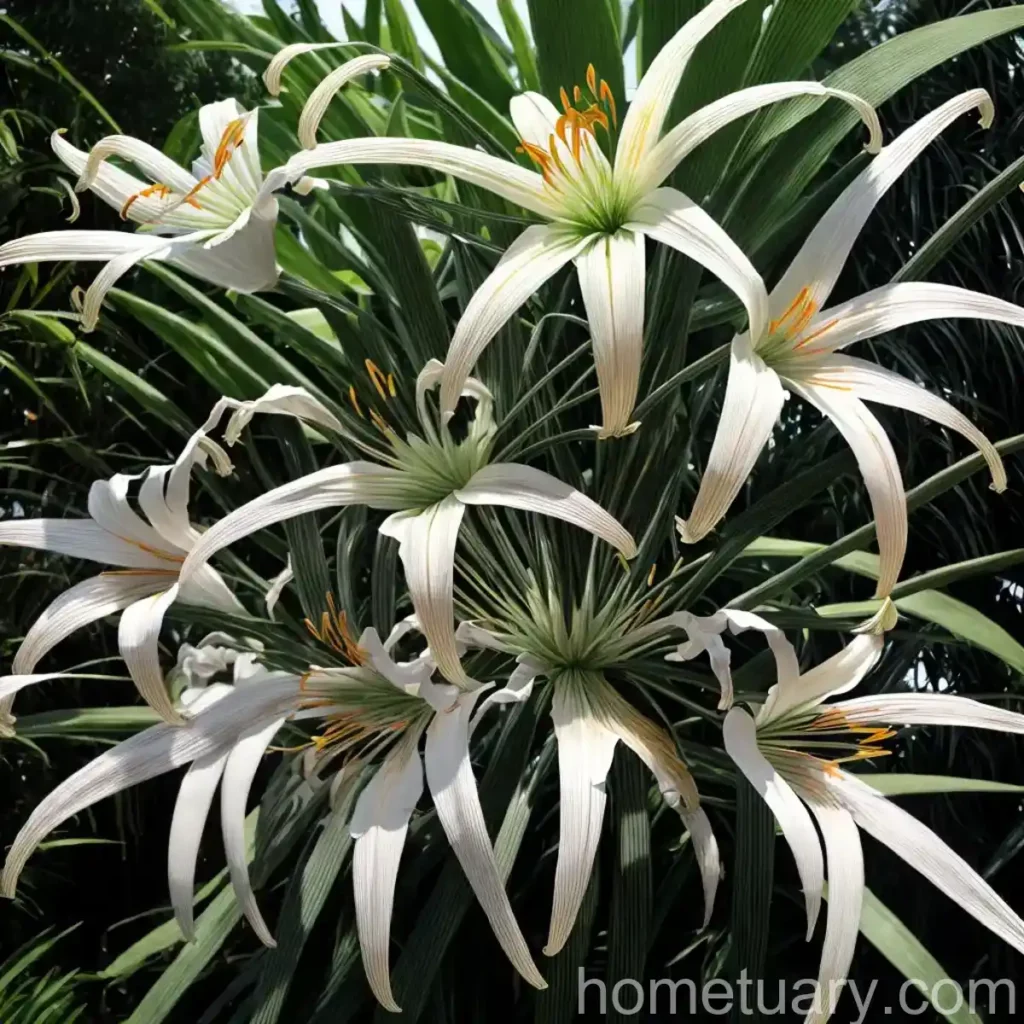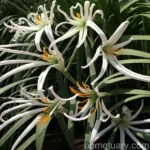The Enchanting Spider Lily (Hymenocallis x festalis)
Introduction
The spider lily, scientifically known as Hymenocallis x festalis, is a captivating plant with delicate and intricate blooms. This perennial bulbous plant belongs to the Amaryllidaceae family, typically adorning gardens with its exceptional beauty. The spider lily’s unique characteristics and versatile nature make it a popular choice for both indoor and outdoor settings. In this comprehensive guide, we will delve into every aspect of caring for spider lilies, from their cultural significance to their growth requirements.
Key Takeaways
Spider Lily (Hymenocallis x festalis)
- Scientific Name: Hymenocallis x festalis
- Common Name: Spider Lily
- Family: Amaryllidaceae
- Plant Type: Perennial bulbous plant
Plant Characteristics
The spider lily is an enchanting flowering plant characterized by its distinct features:
– Striking, star-shaped white flowers with elongated, slender petals
– Narrow, strap-like green leaves that add a graceful touch to the plant’s appearance
– Pleasant, sweet fragrance that enhances the overall allure of the blooms
Spider lilies are well-known for their elegant and captivating appearance, making them a beloved choice for gardeners and flower enthusiasts worldwide.
Cultivation
Uses
The spider lily holds several cultural and horticultural uses, including:
- Ornamental Plant: Widely cultivated for its enchanting blooms, adding beauty to gardens and landscapes.
- Medicinal Purposes: Some species of Hymenocallis are used in traditional medicine for their potential healing properties.
Growing Conditions
Water
Spider lilies thrive best in well-draining soil that is consistently moist but not waterlogged. Here are some essential watering tips for spider lilies:
- Regular Watering: Ensure that the soil is kept evenly moist, particularly during the growing season and blooming period.
- Avoid Waterlogging: Prevent the plant from sitting in waterlogged soil to avoid root rot and other moisture-related issues.
Sunlight
Proper sunlight is vital for the healthy growth and prolific blooming of spider lilies. Consider the following sunlight requirements:
- Partial to Full Sun: Spider lilies prefer an ample amount of sunlight, making them suitable for areas with partial to full sun exposure.
- Protection from Harsh Afternoon Sun: In hot climates, provide some shade or protection from intense afternoon sun to prevent the scorching of delicate petals and leaves.
Fertilizer
To support robust growth and abundant flowering, spider lilies benefit from regular fertilization:
- Balanced Fertilizer: Use a balanced, all-purpose fertilizer to nourish the plants during the growing season.
- Fertilization Frequency: Apply fertilizer every 6-8 weeks during the growing period to promote healthy foliage and stunning blooms.
Soil
Choosing the right soil type is crucial for the successful cultivation of spider lilies:
- Well-Draining Soil: Plant spider lilies in well-draining soil to prevent waterlogged conditions and root rot.
- Rich in Organic Matter: Incorporate organic compost or well-rotted manure to enhance soil fertility and structure.
Pruning
Proper pruning ensures the maintenance of an attractive and healthy spider lily plant:
- Deadheading: Remove spent flowers to encourage continuous blooming and prevent the development of seed pods.
- Leaf Maintenance: Trim yellowing or damaged leaves to maintain the plant’s aesthetic appeal and overall vigor.
Propagation
Spider lilies can be propagated through various methods, including:
- Division: Divide mature clumps of spider lilies during the dormant season to create new plants.
- Seed Propagation: Grow spider lilies from seeds, although this method requires patience and time for the plants to reach maturity and bloom.
Container Gardening
As versatile plants, spider lilies thrive well in containers, adding a touch of elegance to indoor and outdoor spaces. Here are some essential tips for growing spider lilies in containers:
- Pot Selection: Choose well-draining pots with sufficient depth for the growth of the bulb and development of roots.
- Soil Quality: Use a well-aerated, nutrient-rich potting mix that mimics their preferred soil conditions.
- Watering in Containers: Monitor the moisture level closely and avoid waterlogging the soil in containers, as it can lead to root rot.
Common Diseases
Spider lilies are relatively resistant to diseases, but they may occasionally encounter the following issues:
- Fungal Diseases: Watch out for signs of fungal diseases such as leaf spots and bulb rot, especially in overly moist conditions.
- Viral Diseases: Some viruses may affect spider lilies, causing stunted growth and distorted foliage.
Disease Diagnosis
To identify and address potential diseases, carefully inspect the plants for the following symptoms:
- Yellowing or Spotted Leaves: Indicates possible fungal infection or nutrient deficiencies.
- Decaying Bulbs or Roots: Signals the presence of root rot, often due to overly damp soil conditions.
Common Pests
Spider lilies are generally resistant to pest infestations, but they may occasionally attract certain pests:
- Aphids: Watch for aphids that may cluster on the new growth and flower buds, sucking out plant sap and causing distortion of leaves and blooms.
- Thrips: These small, slender insects may feed on flower buds and foliage, leading to damage and discoloration.
Botanist’s Tips
For optimal care and cultivation of spider lilies, consider the following expert tips:
- Adequate Spacing: When planting multiple spider lilies, provide adequate spacing to allow air circulation and minimize the risk of diseases.
- Mulching: Apply a layer of organic mulch around the base of the plants to conserve moisture, suppress weeds, and enhance the soil structure.
Fun Facts
- The genus name, Hymenocallis, is derived from Greek words “hymen,” meaning membrane, and “kallos,” meaning beauty, referring to the delicate membrane-like floral parts.
- Spider lilies are native to the southeastern United States, Mexico, and Central America, where they grow in moist habitats, including swamps and marshes.
Links to External Resources
For further information on spider lilies, explore the following resources:
- Royal Horticultural Society – Hymenocallis
- American Society for the Prevention of Cruelty to Plants – Spider Lilies
- The American Phytopathological Society – Fungal Diseases of Spider Lilies
- University of Florida – Hymenocallis Identification and Control of Common Diseases
Conclusion
The exquisite beauty and adaptability of spider lilies make them an invaluable addition to any garden or landscape. With the right care, suitable growing conditions, and proper maintenance, these enchanting plants can thrive and reward gardeners with their graceful blooms year after year. Whether grown in the garden, containers, or as indoor specimens, spider lilies are sure to captivate with their elegant charm and undeniable allure. In the world of horticulture, the spider lily stands as a timeless symbol of beauty and resilience, enriching the natural environment and bringing joy to all who encounter its delicate blossoms.
By understanding the nuances of spider lily care and cultivation, individuals can embark on a rewarding journey of nurturing these remarkable plants, unveiling the secrets of their folklore, medicinal potential, and ecological significance. As we immerse ourselves in the captivating world of spider lilies, we gain a deeper appreciation for the intricate wonders of the natural world and the fascinating role that plants play in our lives.
References
- Bailey, L.H. (1949). Manual of Cultivated Plants. Macmillan.
- The Plant List (2013). Hymenocallis.
- Smith, G.F., et al. (1995). Flowering Plants of the World. Oxford University Press.
- Stevenson, J.B. (1930). Spices and Herbs. Springer.















